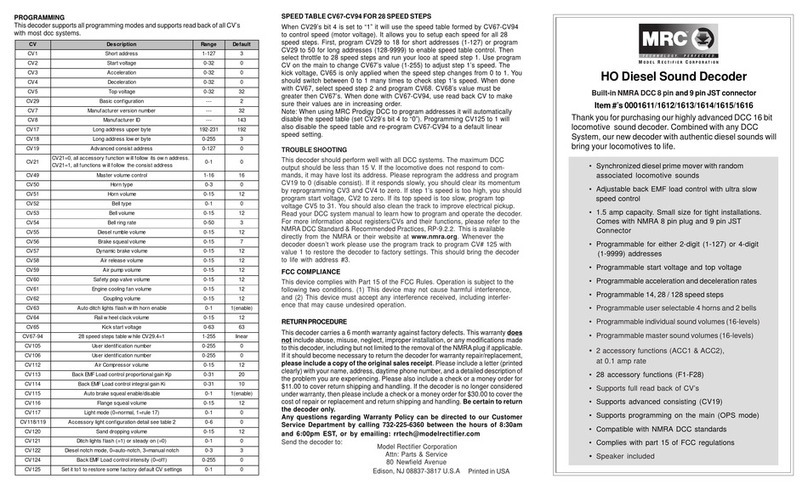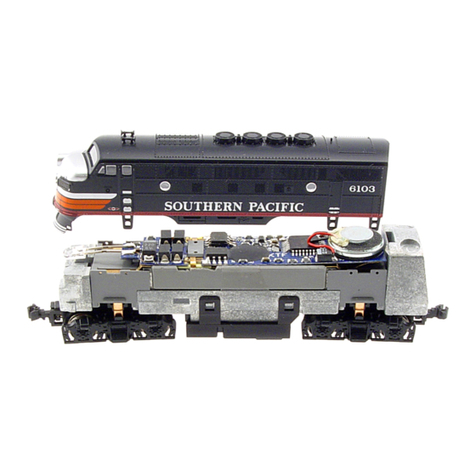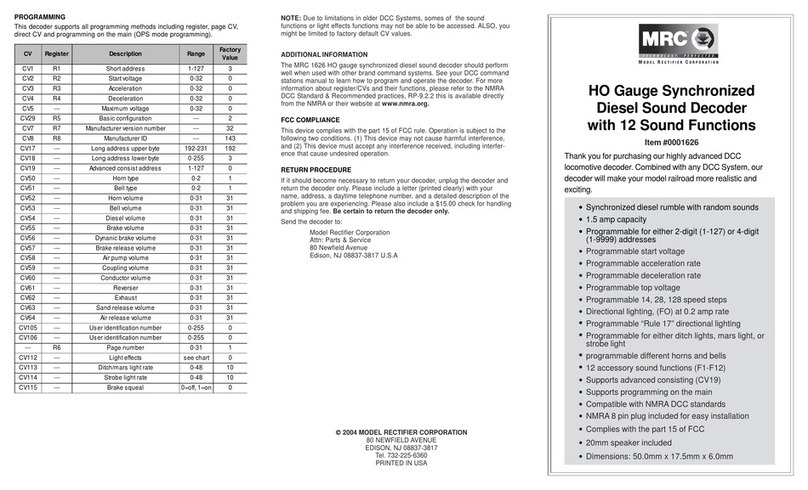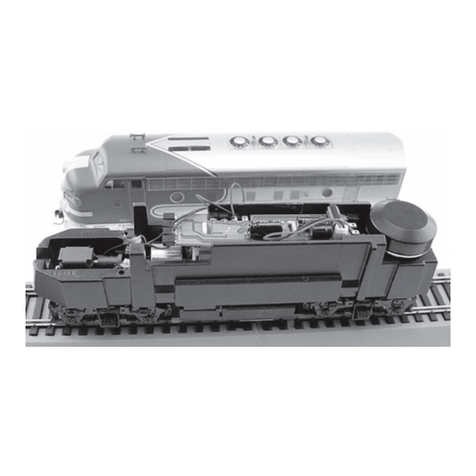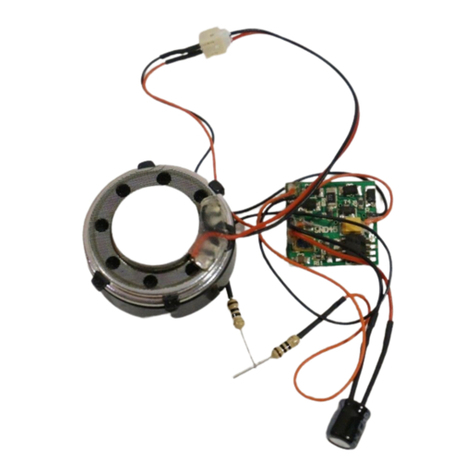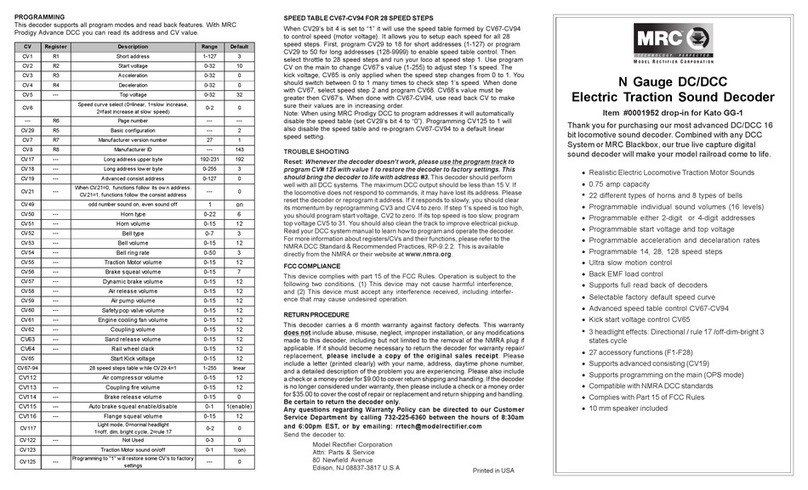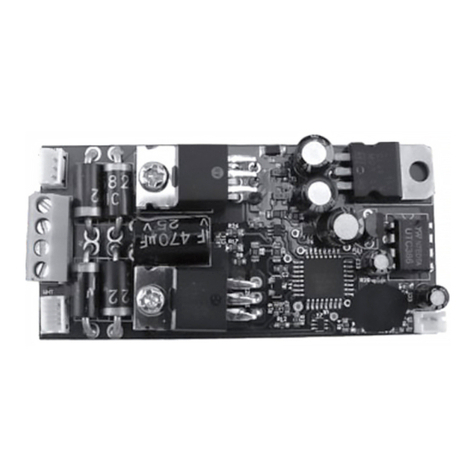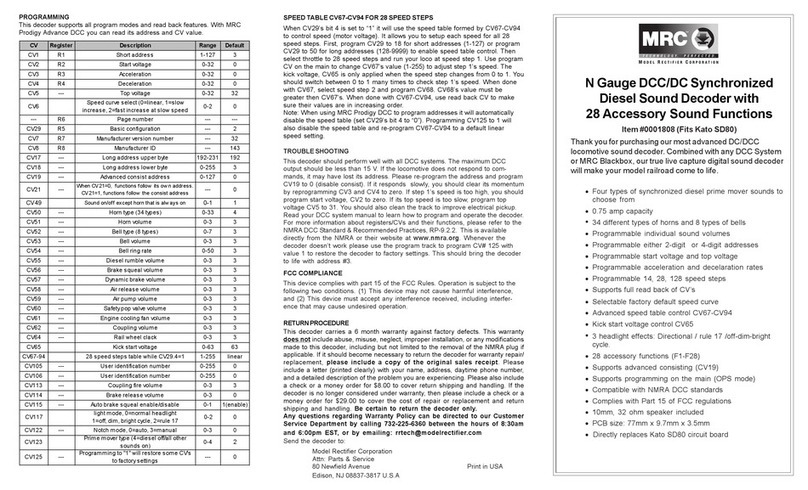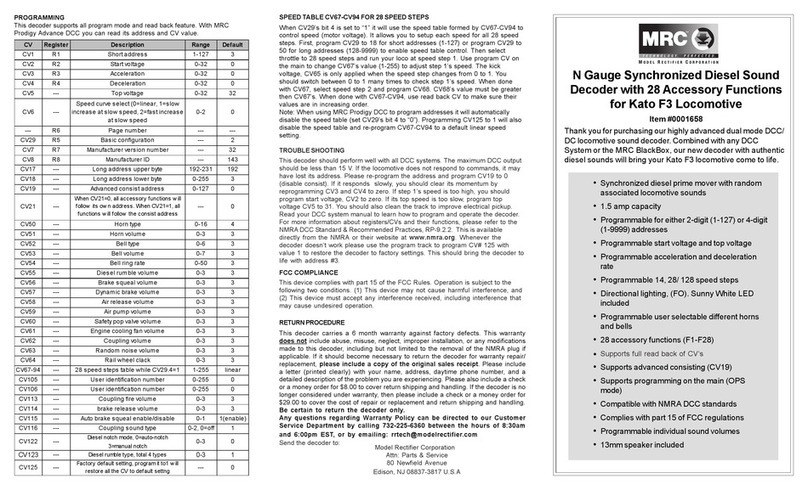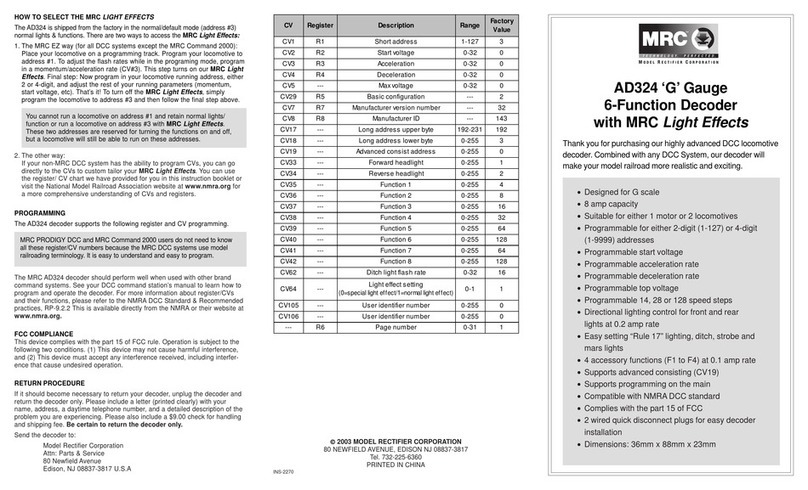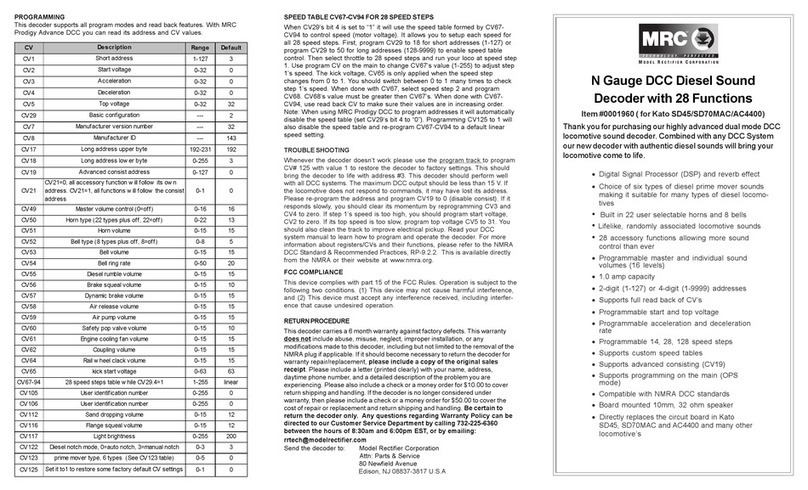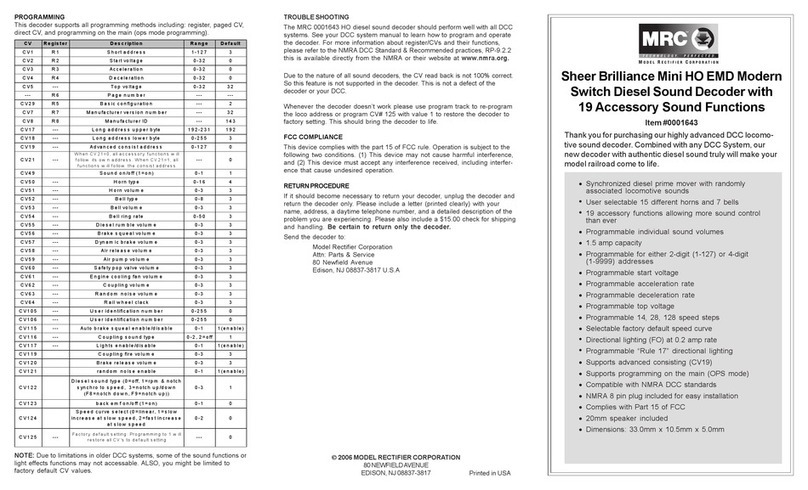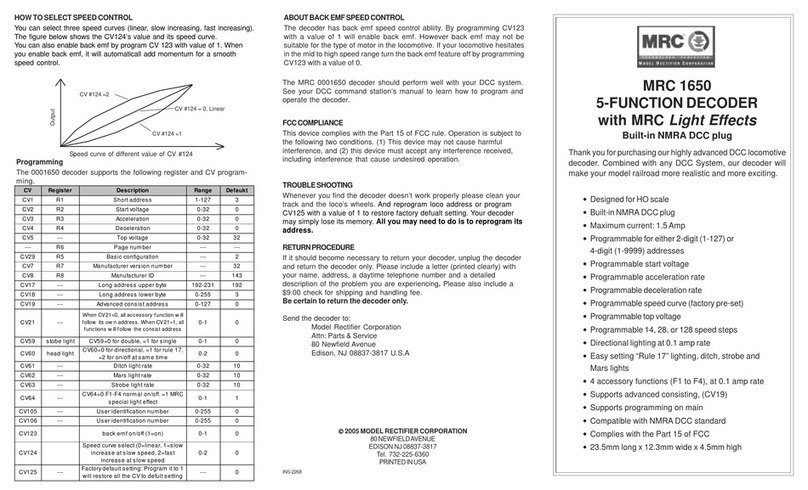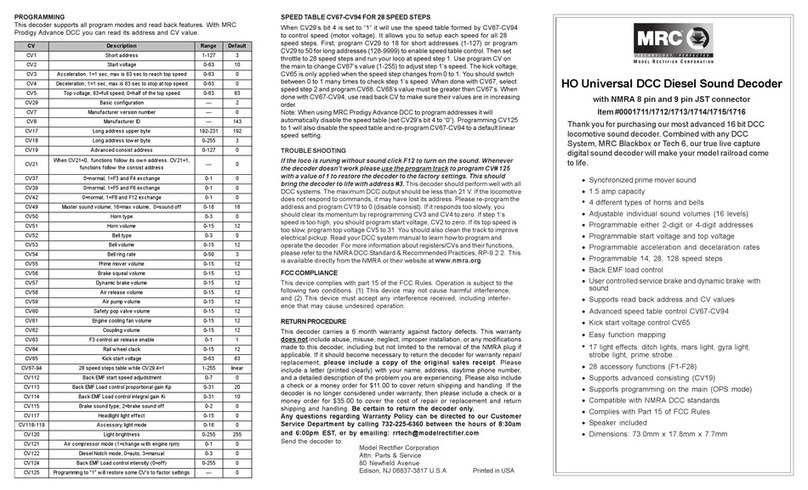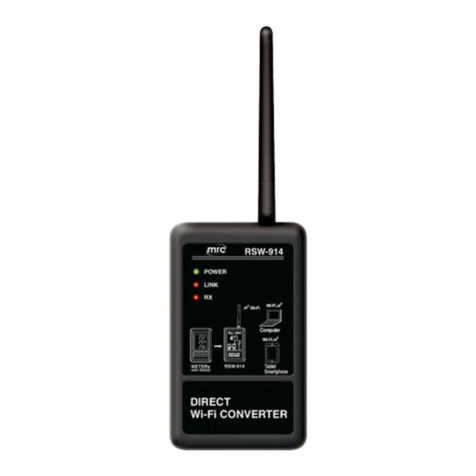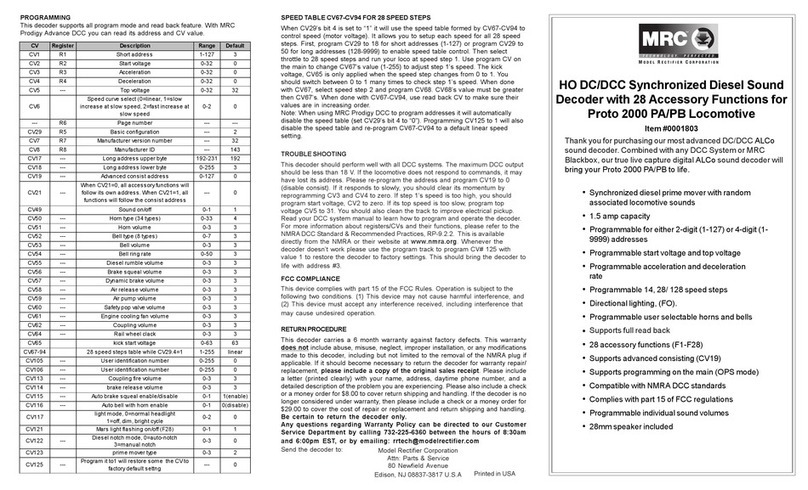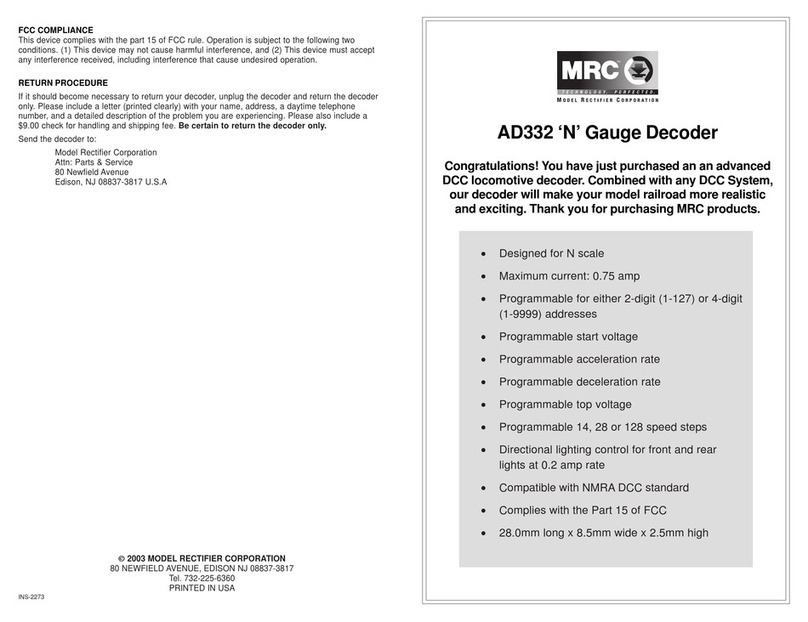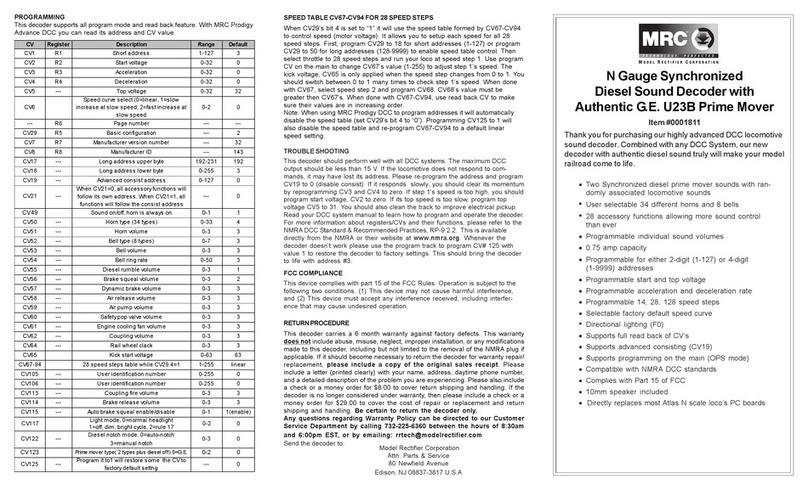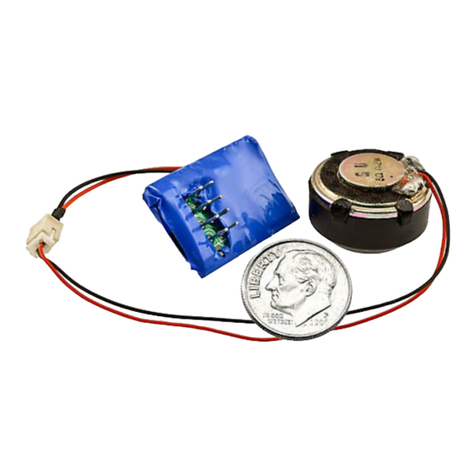
MRC 1651
4-FUNCTION DECODER
with MRC Light Effects
Built-in NMRA DCC & 9-pin plug
Thank you for purchasing our highly advanced DCC locomotive
decoder. Combined with any DCC System, our decoder will
make your model railroad more realistic and more exciting.
•Adjustable back EMF load control with ultra slow
speed control
•Built-in NMRA DCC plug and 9-pin plug
•Maximum current: 1.5 Amp
•Programmable for either 2-digit (1-127) or
4-digit (1-9999) addresses
•Programmable start voltage and top voltage
•Programmable acceleration rate and deceleration rate
•Programmable 14, 28, or 128 speed steps
•Directional lighting at 0.1 amp rate
•Easy setting “Rule 17” lighting, ditch, strobe and
Mars lights
•2 accessory functions (ACC1 & ACC2), at 0.1 amp
rate
•Supports advanced consisting, (CV19)
•Supports programming on main
•Supports full read back
•Compatible with NMRA DCC standard
•Complies with the Part 15 of FCC
•19.30mm long x 17.0mm wide x 5.0mm high
BACK EMF LOAD CONTROL (PID CONTROLLER)
This decoder is equipped with adjustable back EMF closed loop speed
control. Its proportional gain (CV113), integral gain (CV114) and derivative
gain (fixed) are pre-tuned for most locomotives. We recommendend that
you do not change these settings. Too much gain may cause the motor to
oscilate (become unstable). Too little gain may cause slow reponse.
Please get some basic knowledge of PID feedback control before trying to
adjust CV113/114.
With back EMF load control the locomotive will maintain its speed regard-
less of pulling up hill or driving down hill.You may program the back EMF
load control intensity, CV124, to a lower value to get less back EMF load
control. This will enable the locomotive to slow down during uphill travel.
FCC COMPLIANCE
This device complies with the Part 15 of FCC rule. Operation is subject to
the following two conditions. (1) This device may not cause harmful interfer-
ence, and (2) this device must accept any interference received, including
interference that cause undesired operation.
TROUBLE SHOOTING
Whenever you find the decoder doesn’t work properly please clean your
track and the loco’s wheels. And reprogram loco address or program
CV125 with a value of 1 to restore factory defualt setting. Your decoder may
simply lose its memory. All you may need to do is to reprogram its ad-
dress.
RETURN PROCEDURE
This decoder carries a 6 month warranty against factory defects. This
warranty does not include abuse, misuse, neglect, improper installation,
or any modifications made to this decoder, including but not limited to the
removal of the NMRA plug if applicable. If it should become necessary to
return the decoder for warranty repair/replacement, please include a copy
of the original sales receipt. Please include a letter (printed clearly) with
your name, address, daytime phone number, and a detailed description of
the problem you are experiencing. Please also include a check or a money
order for $11.00 to cover return shipping and handling. If the decoder is no
longer considered under warranty, then please contact Model Rectifier
Corp. for a price quote to cover the cost of repair or replacement of the
decoder, and return shipping and handling. Customers outside the
continental United States, including:Hawaii, Alaska, Canada and Mexico,
have to contact MRC for exact return shipping rates for both warranty and
non-warranty repairs. Contact rrtech@modelrectifier.com. Be certain to
return the decoder only. Any questions regarding Warranty Policy can
be directed to our Customer Service Department by calling 732-225-
6360 between the hours of 8:30am and 6:00pm EST, or by emailing:
rrtech@modelrectifier.com
Send the decoder to:
Model Rectifier Corporation
Attn: Parts & Service
80 Newfield Avenue
Edison, NJ 08837-3817 U.S.A
PROGRAMMING
This decoder supports all program modes and read back features. With MRC Prodigy
Advance² DCC you can read its address and CV values.
Please refer your DCC manual to learn how to program CV. See the regis-
ter/CV chart to custom tailor your MRC Light Effects. For a more compre-
hensive understanding of CVs and registers. visit the National Model Rail-
road Association website at www.nmra.org.
CV Register Description Range Default
CV1 R1 Short address 1-127 3
CV2 R2 Start voltage 0-32 0
CV3 R3 Acceleration 0-32 0
CV4 R4 Deceleration 0-32 0
CV5 --- Top voltage 0-32 32
CV29 R5 Basic configuration --- 2
CV7 R7 Manufacturer version number --- 32
CV8 R8 Manufacturer ID --- 143
CV17 --- Long address upper byte 192-231 192
CV18 --- Long address lower byte 0-255 3
CV19 --- Advanced consist address 0-127 0
CV65 0-63 63
CV67-94 1-255 linear
CV105 --- User identification number 0-255 0
CV106 --- User identification number 0-255 0
CV113 0-31 20
CV114 0-31 10
CV117 0-2 0
CV118 ACC1 light type control (green wire) 0-5 0
CV119 ACC1 light type control (pink wire) 0-5 0
CV121 Ditch flash (=1) or stayon (=0) 0-1 0
CV124 0-255 160
CV125 --- Factorydefault setting: Program it to 1
will restore all the CV to defult setting --- 0
0
When CV21=0, all accessory function
will follow its own address. When
CV21=1, all functions will follow the
consist address
0-1
Back EMF Load control proportional gain Kp
28 speed steps table while CV29.4=1
kick start voltage
CV21 ---
Back EMF Load control integral gain Ki
Back EMF Load control intensity (0=off)
0 for directional, 1 for rule 17, 2 for bright and dim












